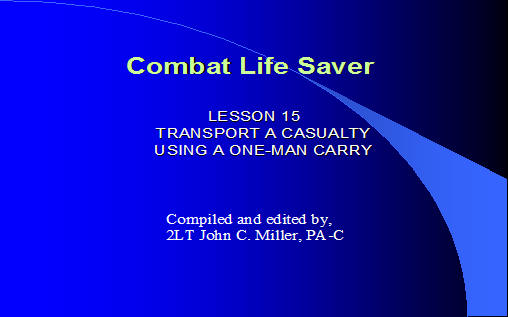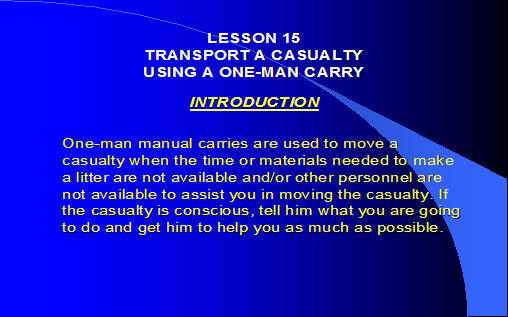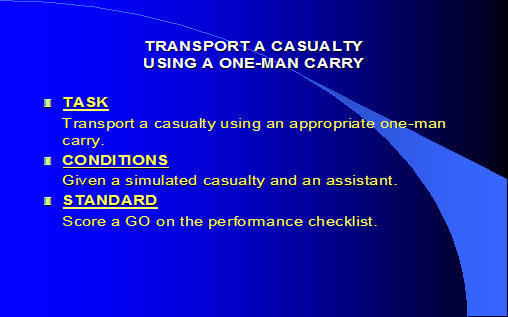Transport a Casualty using a one-man carry
Click here to download the presentation.



LESSON 15
TRANSPORT A CASUALTY
USING A ONE-MAN CARRY
INTRODUCTION
One-man manual carries are used to move a casualty when the time or materials needed to make a litter are not available and/or other personnel are not available to assist you in moving the casualty. If the casualty is conscious, tell him what you are going to do and get him to help you as much as possible.
TRANSPORT A CASUALTY
USING A ONE-MAN CARRY
TASK
Transport a casualty using an appropriate one-man carry.
CONDITIONS
Given a simulated casualty and an assistant.
STANDARD
Score a GO on the performance checklist.
CHOOSE AN APPROPRIATE
ONE-MAN CARRY
When choosing a one-man carry, consider the casualty’s injuries, the military situation, the distance to be covered, the weight of the casualty, your strength and endurance, and obstacles to be encountered.
CHOOSE AN APPROPRIATE
ONE-MAN CARRY
Fireman’s Carry
Used to quickly move an unconscious or conscious casualty.
Can be used to move the casualty a moderate or long distance.
Leaves one of the bearer’s arms free to carry a rifle, move around obstacles, etc.
CHOOSE AN APPROPRIATE
ONE-MAN CARRY
Support Carry
Used only with a conscious casualty who can walk or at least hop on one leg.
Can be used to move a casualty a long distance or until the casualty tires.
Arms Carry
Used to move a conscious or unconscious casualty.
Used to move a casualty a short distance.
CHOOSE AN APPROPRIATE
ONE-MAN CARRY
Saddleback Carry
Used only for a conscious casualty who can put his arm around your neck.
Can be used to move a casualty a moderate or long distance.
Pack-Strap Carry
Used for a conscious or unconscious casualty.
Can be used to move a casualty a moderate distance.
Not used if the casualty has a broken arm.
CHOOSE AN APPROPRIATE
ONE-MAN CARRY
Pistol-Belt Carry
Used to carry a conscious or unconscious casualty.
Can be used to move a casualty a long distance.
Leaves both hands free to use your rifle, climb banks, or move over obstacles.
Pistol-Belt Drag
Used to move a conscious or unconscious casualty.
Used to move a casualty for a short distance.
Keeps rescuer and casualty closer to the ground than any other carry or drag.
CHOOSE AN APPROPRIATE
ONE-MAN CARRY
Neck Drag
Used to move a conscious or unconscious casualty.
Used to move a casualty for a short distance.
Keeps rescuer close to the ground, but not as close as the pistol-belt drag.
Used when moving behind a low wall, under a vehicle, or through a culvert.
Not used if the casualty has a broken arm.
CHOOSE AN APPROPRIATE
ONE-MAN CARRY
Cradle Drop Drag
Used to move a conscious or unconscious casualty.
Used to move a casualty up or down steps or low drops or to quickly move a casualty from a life-threatening situation.
TURN A CASUALTY
Some carries require the casualty to be in a prone position; others require him to be in a supine position.
Kneel at the casualty’s uninjured side.
If you are in a chemical environment, squat–do not kneel.
Place the casualty’s arms above his head and cross his far ankle over the near one.
Grasp the casualty’s clothing at his far shoulder and hip and gently pull so the casualty rolls toward you. Continue until the casualty is turned (on his abdomen or back).
Place the casualty’s arms at his side and straighten his legs.
RAISE A CASUALTY TO A STANDING
POSITION
Some one-man carries requires the casualty be raised to a standing position. If the casualty is conscious, you may be able to assist him to stand up. If the casualty is unconscious, however, you need to raise him to a standing position without his help.
RAISE A CASUALTY TO A STANDING
POSITION
Regular Method
Position the casualty in a prone position.
Straddle the casualty, slip your hands under his chest, and lock your hands together.
Lift the casualty and begin walking backward until he is on his knees.
Continue walking backward until his legs are straight and his knees are locked.
RAISE A CASUALTY TO A STANDING
POSITION
Walk forward and bring the casualty to a standing position. Keep the casualty tilted slightly backward so his knees will remain locked. If his knees do not remain locked, walk backward until they lock and then move forward until the casualty is in the standing position.
Grasp one of the casualty’s wrists and raise his arm. Use your other arm to hold the casualty erect.
RAISE A CASUALTY TO A STANDING
POSITION
Move under the casualty’s arm to his front, lower his arm, and put both of your arms around the casualty’s waist to support the casualty. Interlock the fingers of your hands.
Place your foot between the casualty’s feet and spread them so his feet are about six to eight inches apart.
RAISE A CASUALTY TO A STANDING
POSITION
Alternate Method
This method is used if it will be safer for the casualty due to his injuries.
Position the casualty in a prone position.
Kneel on one knee at the casualty’s head, facing the casualty’s feet.
If you are in a chemical environment, squat–do not kneel.
Put your hands under his armpits, down his sides, and across his back.
RAISE A CASUALTY TO A STANDING
POSITION
Rise, lifting the casualty to his knees. Keep the casualty’s head from snapping back.
Lower your arms, secure a hold on the casualty, and raise him to a standing position with his knees locked.
Put your arms around the casualty’s waist, interlock your fingers, and tilt his body slightly backward to keep his knees from buckling.
Place your foot between his feet and spread them so his feet are six to eight inches apart.
PERFORM THE FIREMAN’S CARRY
Raise the casualty to a standing position.
Grasp the casualty’s wrist and lift his arm over his head while continuing to support the casualty with your other arm.
If the casualty has an injured arm, grasp the wrist of the uninjured arm.
Bend at the waist and kneel, pulling the casualty over your shoulder. At the same time, slip your arm from his waist, pass the arm between the casualty’s legs, and grasp behind the casualty’s knee.
Move the hand grasping the casualty’s wrist to the hand at the casualty’s knee.
PERFORM THE FIREMAN’S CARRY
Grasp the casualty’s wrist with the hand behind the casualty’s knee, thus freeing the hand that previously held the wrist.
Place your free hand on your knee and push on your knee to slowly rise to a standing position. This will help to prevent back strain.
Adjust the casualty’s body so his weight is distributed comfortably.
Move forward, carrying the casualty.
PERFORM THE SUPPORT CARRY
Position the casualty in a sitting position.
Bend down at the casualty’s side so you are facing in the same direction as the casualty.
If the casualty has an injured leg, position yourself with the injured leg next to you.
Bring the casualty’s near arm over your shoulder and grasp his wrist with your hand that is away from the casualty.
Put your inside arm around the casualty’s waist.
PERFORM THE SUPPORT CARRY
Stand up, helping the casualty to rise to a standing position also.
Assist the casualty to walk or hop on one leg.
Adjust your walking motion as needed to help the casualty maintain his balance.
PERFORM THE ARMS CARRY
Raise the casualty to a standing position.
Slide one of your arms under the casualty’s arm, behind his back, and under his other arm.
Move to the casualty’s side, bend down, and place your other arm behind the casualty’s knees.
Lift the casualty from the ground and stand erect.
Carry the casualty high on your chest to lessen fatigue.
PERFORM THE SADDLEBACK CARRY
Raise casualty to a standing position or have the casualty stand up.
Grasp the casualty’s wrist and lift his arm over his head while continuing to support the casualty with your other arm.
Turn so your back is to the casualty and bring his arm over your shoulder. Support the casualty’s waist with your other arm, if needed.
Grasp the casualty’s other wrist and lift his arm over your shoulder or have the casualty put his other arm around your neck.
PERFORM THE SADDLEBACK CARRY
Have him grasp one of his wrists with his other hand.
Stoop and move your arms around the outside of the casualty’s thighs.
Bring your hands inside the casualty’s thighs to your sides, lifting his thighs.
Stand up and clasp your hands together in front of you.
Adjust the casualty to make the weight distribution more comfortable.
Walk forward.
PERFORM THE PACK-STRAP CARRY
Raise the casualty to a standing position.
Grasp one of the casualty’s wrists and lift his arm above his head while continuing to support the casualty’s waist with your other arm.
Turn so your back is to the casualty. Bring the casualty’s raised arm over your shoulder as you turn.
Bend your knees somewhat so your shoulder fits under his arm.
PERFORM THE PACK-STRAP CARRY
Release his waist, grasp his other wrist, and bring that arm over your other shoulder.
Hold both wrists so his hands are in a palms down (palms toward your body) position. Twisting his hands could result in injury to the casualty’s joints when he is lifted and carried.
Bend forward and lift the casualty as high on your back as possible.
Walk forward, keeping bent so the casualty’s weight is balanced on your back and his feet are not dragging.
PERFORM THE PISTOL-BELT CARRY
Form a sling by joining two fully-extended pistol belts together to form one large loop. If pistol belts are not available, use material which will not break and which will not cut or bind the casualty, such as a rifle strap or cravat bandages.
Position the casualty on his back.
Slip the sling under the casualty so the top part of the loop is under his lower back, the bottom part of the loop is under his thighs, the belt buckles are centered behind the casualty, and a loop end extends from each side.
PERFORM THE PISTOL-BELT CARRY
Move the casualty’s legs apart and lie between them on your back.
Thrust your arms through the loop ends and fit the loop ends over your shoulders.
Grasp the casualty’s wrist and his trouser leg on his injured side.
Roll toward the casualty’s uninjured side and onto
your abdomen. (Both you and the casualty are now in a prone position.)
Release the casualty’s wrist and leg and push yourself up until you are on your knees.
PERFORM THE PISTOL-BELT CARRY
Rise to a kneeling position and place your hand on your knee for support.
Rise to your feet. Lean forward to balance the casualty’s weight.
Adjust the casualty’s body so the weight is distributed comfortably.
Walk forward.
Your hands are free to carry a rifle, climb obstacles, etc.
If the casualty is conscious, have him put his arms around your neck.
If the casualty is unconscious and you do not have to carry anything in your hands, grasp his wrists (palms down) to help balance the casualty while you are walking.
PERFORM THE PISTOL-BELT DRAG
Extend two (or three) pistol belts to their full length and join them together to make one large loop. Other materials, such as a rifle sling or cravats, can be used if pistol belts are not available.
Position the casualty on his back.
Slip one end of the loop across the casualty’s chest, under his armpits, and under his shoulders.
Twist the remainder of the loop above his head to form a figure 8. Adjust the belts so the buckles cross in the center of the figure 8.
PERFORM THE PISTOL-BELT DRAG
Lie on your side facing the casualty with your head in the same direction as the casualty’s head. Support yourself on your elbow.
Slip the arm on which you are resting through the top loop of the figure 8 and bring the loop over your shoulder.
Turn onto your abdomen. The sling is now across and under your chest and the loop is on the shoulder away from the casualty.
Crawl, dragging the casualty with you.
PERFORM THE NECK DRAG
Position the casualty on his back.
Tie the casualty’s hands together with material which will not cut his wrists, such as a field dressing or a cravat. Do not tie the materials tight enough to interfere with the blood circulation.
If the casualty is conscious, tell him to interlock his fingers.
Face the casualty’s head and straddle his hips on your knees.
Loop the casualty’s arms around your neck.
Crawl forward on your hands and knees, dragging the casualty beneath.
Keep the casualty’s head from dragging on the ground.
PERFORM THE CRADLE DROP DRAG
Position the casualty on his back.
Kneel at the casualty’s head.
Slide your hands (palms up) under his shoulders and grasp the clothing under his armpits.
Partially rise, pulling the casualty to a semi-sitting position.
Support his head on one of your arms.
If possible, bring your elbows together and use both forearms to support the head.
Rise to a stooped position.
Walk backward, dragging the soldier backward.
If you go down steps, let his hips and legs drop from step to step.
TRANSPORT A CASUALTY
USING A ONE-MAN CARRY
CLOSING
One man carries are used to quickly remove a casualty from a source of danger, such as a burning building or enemy fire. They are also used to evacuate a casualty when other methods are not available. Being able to perform the carries rapidly and properly will help to get both the casualty and yourself to a place of safety quickly.
Questions